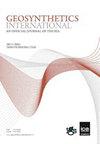传感器驱动的压电带加筋土拉出摩擦信号响应
IF 3.3
2区 工程技术
Q2 ENGINEERING, GEOLOGICAL
引用次数: 0
摘要
土工合成材料在土体加固工程中得到了广泛的应用,而土工合成材料的破坏模式通常为拉拔模式。然而,目前对加筋土拉拔损伤监测的研究还很有限。因此,本研究测试了能够捕捉加筋土在不同拉伸破坏条件下的拉伸振动信号的传感器型压电地震带(SPGB)的应力变化规律和信号输出特性。我们观察到SPGB捕获了不同土壤环境、围压和剪切速率下的响应信号。在拔出摩擦过程中,会产生一个尖峰,尖峰位置对应的位移会随着拔出摩擦率的增加而增加。在粘土环境下,尖峰电压与围压有关,而在砂土环境下,尖峰电压与围压无明显关系。在砾石环境中,由于砾石颗粒的嵌入,SPGB的输出电压波动较大,出现了许多幅值较大的负电压。该研究验证了SPGB在土体加固与监测一体化方面的良好应用潜力,对SPGB在工程中的进一步应用具有重要意义。本文章由计算机程序翻译,如有差异,请以英文原文为准。
Response of sensor-enabled piezoelectric geobelt reinforced soil pullout friction signals
Geosynthetics are widely used in soil reinforcement engineering, where the failure modes of geosynthetics are typically pullout modes. However, current research on monitoring the pullout damage experienced by reinforced soil is limited. Accordingly, this study tested the stress variation laws and signal output characteristics of a sensor-enabled piezoelectric geobelt (SPGB) that can capture the tensile vibration signals of reinforced soil under various tensile failure conditions. We observed that the SPGB captures the response signals under different soil environments, confining pressures, and shear rates. During the pullout friction process, a spike is generated, and the displacement corresponding to the position of the spike will increase with the increase of the pullout friction rate. In the clay environment, the spike voltage is related to the confining pressure, while in the sand environment, there is no obvious relationship between the spike voltage and the confining pressure. In the gravel environment, the output voltage of SPGB fluctuates greatly, due to the embedment of gravel particles, and many negative voltages with large amplitude appeared. This study verified the promising application potential of the SPGB for the integration of soil reinforcement and monitoring, which is significant for further application of SPGB in engineering.
求助全文
通过发布文献求助,成功后即可免费获取论文全文。
去求助
来源期刊

Geosynthetics International
ENGINEERING, GEOLOGICAL-GEOSCIENCES, MULTIDISCIPLINARY
CiteScore
6.90
自引率
20.00%
发文量
91
审稿时长
>12 weeks
期刊介绍:
An online only, rapid publication journal, Geosynthetics International – an official journal of the International Geosynthetics Society (IGS) – publishes the best information on current geosynthetics technology in research, design innovation, new materials and construction practice.
Topics covered
The whole of geosynthetic materials (including natural fibre products) such as research, behaviour, performance analysis, testing, design, construction methods, case histories and field experience. Geosynthetics International is received by all members of the IGS as part of their membership, and is published in e-only format six times a year.
 求助内容:
求助内容: 应助结果提醒方式:
应助结果提醒方式:


